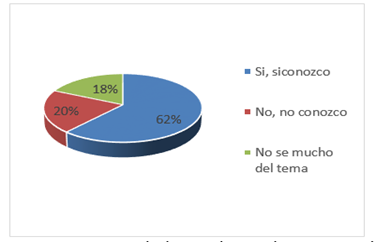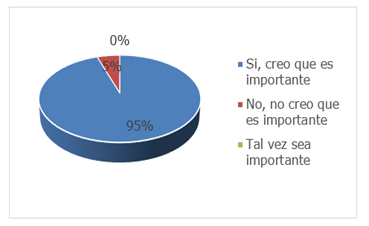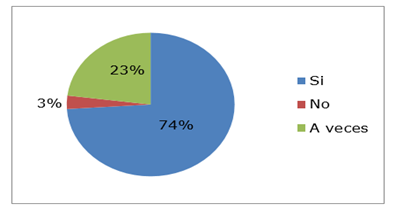Mi SciELO
Servicios Personalizados
Articulo
Indicadores
-
 Citado por SciELO
Citado por SciELO
Links relacionados
-
 Similares en
SciELO
Similares en
SciELO
Compartir
Revista de Ciencias Médicas de Pinar del Río
versión On-line ISSN 1561-3194
Rev Ciencias Médicas vol.27 supl.1 Pinar del Río 2023 Epub 01-Jul-2023
Articles
Preventive techniques for an adequate oral care in children of the Julio Moreno School Espinosa, Ecuador
1Autonomous Regional University of the Andes (UNIANDES)
ABSTRACT Introduction: good oral health is important from the important from the first years of a child's life. This consists in having a correct hygiene, periodical controls, adequate nutrition, not consuming sweets in excess, this will help to avoid oral problems in adolescence and adulthood. Objective: to evaluate the level of knowledge of parents with children from three to five years old about oral hygiene and preventive techniques. Methods: an observational, descriptive cross-sectional, descriptive, observational and cross-sectional study of parents with children from 3 to 5 years of age children from three to five years of age on oral hygiene and preventive techniques, from September to November 2022. The universe was constituted by 50 parents, the sample was constituted by 39, obtained by simple random sampling and the inclusion and exclusion criteria. The data were obtained from a survey elaborated for this purpose. The data were tabulated using Microsoft Excel in percentages. Results: It was found that 62 % of the parents know which toothpastes are suitable for their children, 21 % do not know which toothpastes are suitable for their children, 21 % do not know what toothpastes are suitable for their children, and 18 % do not know much about and 18 % do not know much about it. Ninety-five percent of the parents recognize that it is important to visit the dentist periodically and 5 % do not think it is necessary at such an early age. necessary at such an early age. It was found that 74 % of the parents supervise their children's brushing parents supervise the brushing of their children three times a day, 3 % do not do it and 23 % do it sometimes. Conclusions: educating children towards good oral health is paramount to prevent caries and other diseases. With proper guidance, they will progressively adopt habits and behaviors health-oriented habits and behaviors as part of their daily routine.
Key words: ORAL HEALTH; PREVENTION; CARIES; TECHNIQUES.
INTRODUCTION
Having a good oral health is important from the first years of a child's life, this consists in having a correct hygiene, regular dental checkups, adequate nutrition, not consuming sweets in excess, this will help to avoid oral problems in middle and adult ages, in children it is easy to accustom them to acquire habits of hygiene that will last a lifetime, since being the age in which they can be better trained it is easy to instill healthy habits, Nowadays we can see that there is a large number of children who have problems with cavities and gums, this is due to poor oral hygiene and neglect by parents, since they are responsible for their children to acquire these habits of cleanliness and carry out measures of prevention and oral protection, since bad habits can cause serious pathologies and even the loss of teeth.1
The mouth is one of the most important organs of the digestive system, since it is where the process begins, the components of the mouth: teeth, gums, tongue are important to process the food we eat is for this reason that we must take care of this part of the body to prevent the onset of oral diseases. Educating children for a good oral health is essential to prevent cavities and other diseases for this reason children should be made aware from an early age and start with good oral hygiene habits because as they are small as they grow into adulthood these habits will last, we must be aware that the lack of oral hygiene in children is due to the lack of information that exists in society.2,3)
It is worth mentioning that the stages of child development are important for the development of oral hygiene tips, which include stage 1 (four-24 months), to notice the accumulation of plaque, a soft and viscous layer in which bacteria are deposited that accumulates on the teeth and causes tooth decay, parents normally clean the gums of their newborn with a damp cloth after breastfeeding or bottle feeding. When a child's first tooth comes in, brush the teeth for two minutes twice a day and start using a special soft-bristled toothbrush for children with a cushioned head and a small amount of fluoride-free toothpaste. Concerning stage 2 (2-4 years), children older than two years should use fluoride toothpaste to prevent caries as their teeth continue to develop.4,5)
Even so, as a parent's duty, you should continue to supervise them and brush them again to make sure they are clean, in stage 3 (five-seven years), even if young children think they can brush themselves, most do not develop the manual dexterity to brush their teeth properly until they are seven years old, so parental supervision and, if needed, flossing is needed, and stage 4 (ages eight and older), as children start to grow up and go to school, parents no longer control what they eat during the day. Set an example for your child by following a healthy, balanced and varied diet and a regular oral hygiene routine that includes brushing twice a day and flossing daily.6
Children's dental health is very important and this is taken care of through proper dental hygiene habits such as those which are recommended: good brushing with a good technique, brushing their teeth with fluoride-based toothpaste that is appealing to children and that they take the initiative to care for themselves, inspecting their brushing, as this helps them to correct any brushing mistakes, and flossing from the age of seven. Teaching children good oral hygiene habits at an early age can translate into a lifetime of healthy smiles and a lifetime of beautiful smiles. Techniques you do to improve good technique in proper oral hygiene start cleaning your baby's mouth during the first few days after birth; wipe the gums with a clean, damp gauze or washcloth. As soon as teeth appear, tooth decay may appear.7,8
Teeth are the first thing you see when you smile, and if brushing is not done properly, decay is likely to develop and teeth will be affected. This can create a sense of embarrassment when showing teeth and affect behaviors in the child's environment. If this persists throughout their growth, there is the possibility of generating low self-esteem and this can lead to something more serious. A low child self-esteem is a very serious problem that develops in a very negative way as an adult. As parents, it is our duty to educate our children in proper oral hygiene so that, throughout their lives, the psychological problems derived are minimal and they can develop healthy and happy relationships.9,10
There are many factors that develop low self-esteem at an early age, but we should not underestimate those derived from dental health. We all like to see a good smile and we are happy to be able to smile in the same way. The diseases caused by poor oral health care in the oral cavity appear due to many factors, the main one being poor oral health care, poor diet and these same factors cause caries, gingivitis, periodontitis, halitosis, these affectations often lead to psychological and social problems such as lack of self-esteem, social rejection or depression.11
Therefore, it was decided to carry out a study to evaluate the level of knowledge of parents with children from three to five years old who attend the "José Luis Riofrio" school, located in the city of Santo Domingo, about oral hygiene and preventive techniques.
METHODS
An observational, descriptive and cross-sectional study was carried out in parents with children from three to five years old, attending the "José Luis Riofrio" school, located in the city of Santo Domingo, Ecuador, on oral hygiene and preventive techniques, from September to November 2022. The universe was constituted by 50 parents, the sample was constituted by 39, obtained by simple random sampling and the inclusion and exclusion criteria. The data were obtained from a survey prepared for this purpose. The data were tabulated using Microsoft Excel in percentages.
Inclusion criteria
Parents with children aged three to five years, of both sexes, who agreed to participate in the study.
Exclusion criteria
Parents with children from three to five years of age, of both sexes, who do not agree to participate in the study.
The variables used were: parental knowledge of toothpastes, parental knowledge of the importance of visiting the dentist, control of brushing by parents of their children.
The survey technique was used for data collection, where the opinions, attitudes and behaviors of the parents when it comes to oral care of their children can be known, with a high level of consistency, which demonstrates the reliability of the instrument. For the realization of the survey and its analysis, the technique and the Google Form instrument were used, where the answers of each person were determined and analyzed upon completion of the survey.
The principles of medical ethics and the aspects established in the Declaration of Helsinki were complied with. It was explained to the patients that the data obtained would only be used for research purposes.
RESULTS
It was obtained that 62 % of the parents know which toothpastes are suitable for their children, 21 % do not know and 18 % do not know much about the subject, taking into account that the population that does not know about the subject is 34,10 % is a worrying and striking figure (Graph 1).
95 % of the parents recognize that it is important to visit the dentist periodically and 5 % do not think it is necessary at such an early age. (Graph 2).
It was found that 74 % of the parents supervise their children's brushing three times a day, 3 % do not do it and 23 % do it sometimes. This is a fundamental issue that requires attention, and more so in this issue regarding the oral care of their children (Graph 3).
DISCUSSION
From this research and obtaining the necessary data to establish which are the important points that the population should take into account regarding the oral hygiene care of their children, we can say that there is a large number of parents who know about the subject, the risks and their responsibility but the percentage who do not know or know but do not do it is also significant, so we understand that there is a large number of children who do not have the necessary care and preventive measures to help them have a good oral health.
We were able to get an idea that parents have a knowledge based on the care of their children's mouths, however we cannot be lucky enough to talk about all parents, since education comes from home and sometimes they do not have the education and do not know how the proper oral care should be given to children who are the future, in them the healthy smile is shaped.
In the "Isla de Pinos" Popular Council of the Cruces Municipality (Cuba), a quasi-experimental intervention study was carried out in order to favorably modify the oral health knowledge of mothers with preschool children living in the area, from January 2006 to November 2007. Radical changes were observed in the mothers' attitude towards their children's oral health. The initial evaluation also showed deficient levels of knowledge, which ostensibly improved after the educational intervention.12
Another study carried out in the city of Medellin (Colombia), with the objective of identifying the frequency of dental caries in children under six years of age and describing the knowledge and oral care practices of their mothers, showed that 42 % of mothers in the medium-high socioeconomic level and 50 % in the low socioeconomic level stated that they had not received information on oral care for their children.13
Another team of researchers evaluated, also in Medellin, the level of knowledge after an educational intervention, in which it is highlighted that the level of knowledge increases ostensibly without reporting the initial or final figures of the same. A total of 178 mothers participated in the program and stood out in the questions on the time of initiation of oral hygiene and the consequences of prolonged pacifier use. They demonstrated that the educational talks are effective as a tool to raise the level of knowledge of mothers and caregivers of children under six years of age. Thus, 70,9 % of the participants with babies aged 10-12 months had a good level of knowledge; in the group of mothers of children aged seven to nine months the frequency was 66,6 %.14
CONCLUSIONS
Preventive techniques for proper oral care in children are important to help prevent caries and other diseases that are caused by inadequate oral hygiene. Oral hygiene consists of taking care of the teeth, gums, tongue and the entire oral cavity. This is achieved by adopting proper oral hygiene habits such as brushing, flossing, regular visits to the dentist and not consuming excessive foods high in sugars, since the consumption of these can lead to tooth decay and other diseases caused by poor oral hygiene. The results of this survey showed that the guardians of the infants are not always aware of the oral care of the children and that most of them did not know how a dental abnormality in the infant can cause low self-esteem leading to depression, isolation and poor academic performance.
BIBLIOGRAPHIC REFERENCES
1. Section On Oral Health. Maintaining and improving the oral health of young children. Pediatrics [Internet]. 2014 Dec [citado 28/11/2022]; 134(6):1224-9. Disponible en: Disponible en: https://pubmed.ncbi.nlm.nih.gov/25422016/ 1. [ Links ]
2. Inocente-Díaz ME, Pachas-Barrionuevo F de M. Educación para la Salud en Odontología. Rev Estomat Herediana [Internet]. 2012 [citado 27/11/2022]; 22(4): 232-41. Disponible en: Disponible en: https://revistas.upch.edu.pe/index.php/REH/article/view/91 2. [ Links ]
3. Saavedra NB. Educación para la conservación de la salud bucal. Rev Odont Mex [Internet]. 2020 [citado 27/11/2022]; 24(4):228-32. Disponible en: Disponible en: https://www.medigraphic.com/cgi-bin/new/resumen.cgi?IDARTICULO=101874 3. [ Links ]
4. Zou J, Hua Xi Kou Qiang Yi Xue Za Zhi. [Oral health management for children]. [Internet]. 2018 oct [citado 28/11/2022]; 36(5):465-8. Disponible en: Disponible en: https://pubmed.ncbi.nlm.nih.gov/30465336/ 4. [ Links ]
5. Consecuencias del mal cuidado bucodental y cómo evitarlas, Consejos] [Internet]. Odontomecum Blog; 2018 [citado 11/11/2022]. Disponible en: Disponible en: https://www.dvd-dental.com/blogodontomecum/consecuencias-mal-cuidado-bucodental/ 5. [ Links ]
6. Lebrun-Harris LA, Canto MT, Vodicka P, Mann MY, Kinsman SB. Oral Health Among Children and Youth With Special Health Care Needs. Pediatrics [Internet]. 2021 Aug [citado 28/11/2022]; 148(2): e2020025700. Disponible en: Disponible en: https://pubmed.ncbi.nlm.nih.gov/34290133/ 6. [ Links ]
7. Ghandour RM, Hirai AH, Kenney MK. Children and Youth With Special Health Care Needs: A Profile. Pediatrics [Internet]. 2022 jun [citado 28/11/2022]; 149(Suppl 7): e2021056150D. Disponible en: Disponible en: https://pubmed.ncbi.nlm.nih.gov/35642877/ 7. [ Links ]
8. Kenney MK, Chanlongbutra A, Fanflick PL, Ferrero A, Kim S, Novoa C. Systems of care among children and youth with special health care needs with and without adverse childhood events: National Survey of Children’s Health 2016-2017. Disabil Health J [Internet]. 2022 Apr [citado 28/11/2022];15(2):101226. Disponible en: Disponible en: https://pubmed.ncbi.nlm.nih.gov/34772650/ 8. [ Links ]
9. Okunseri C, Gonzalez C, Hodgson B. Children’s Oral Health Assessment, Prevention, and Treatment. Pediatr Clin North Am [Internet]. 2015 Oct [citado 28/11/2022]; 62(5):1215-26. Disponible en: Disponible en: https://pubmed.ncbi.nlm.nih.gov/26318948/ 9. [ Links ]
10. Kagihara LE, Niederhauser VP, Stark M. Assessment, management, and prevention of early childhood caries. J Am Acad Nurse Pract [Internet]. 2009 Jan [citado 27/11/2022]; 21(1):1-10. Disponible en: Disponible en: https://pubmed.ncbi.nlm.nih.gov/19125889/ 10. [ Links ]
11. Yost J, Li Y. Promoting oral health from birth through childhood: prevention of early childhood caries. MCN Am J Matern Child Nurs [Internet]. 2008 [citado 28/11/2022]; 33(1):17-23; quiz 24-5. Disponible en: Disponible en: https://pubmed.ncbi.nlm.nih.gov/18158522/ 11. [ Links ]
12. Menguez Becerra T, Sexto Delgado N, González Beriau Y. Programa educativo sobre salud bucal para madres con niños en edad preescolar. MEDISUR. [Internet] 2009 [Citado 28/11/2022]; 7(1) Disponible en: Disponible en: https://www.redalyc.org/pdf/1800/180020302006.pdf 12. [ Links ]
13. Higiene oral para niños: Empezar pronto y bien, todo Papás. [Internet]. Actualizado 2020 [citado 28/11/2022]; pág. 1-3. Disponible en: Disponible en: http://www.todopapas.com/ninos/cuidadosinfantil/higiene 13. [ Links ]
14. Campos L, Rabaldo Bottan E, Bez Birolo J, Garcia da Silveira E, Eger Schmitt BH. Conhecimento de mães de diferentes classes sociais sobre saúde bucal no município de Cocaldo Sul (SC). RSBO Rev Sul-Bras Odontol. [Internet]. 2010 [citado 28/11/2022]; 7(3):287-95. Disponible en: Disponible en: https://www.redalyc.org/articulo.oa?id=153017325007 14. [ Links ]
Received: March 08, 2023; Accepted: May 10, 2023











 texto en
texto en 





